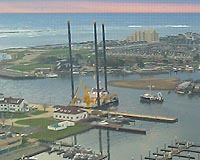| . |  |
. |
Santiago (AFP) May 13, 2009 An ambitious gold mining project in northern Chile, high up in the Andes close to ancient glaciers, is finally getting underway amid the economic downturn despite fears from environmentalists. Assurances the vast project will create some 5,000 badly needed jobs, have failed to overcome skepticism that the project, more than 16,000 feet (5,000 meters) above sea level, could impact on the vast mountain wilderness. Mining officials have said glaciers Toro 1, Toro 2 and Esperanza will not now be removed, as had been called for in the initial proposal put forward some 15 years ago by Canadian company Barrick Gold. The glaciers cannot be "moved, displaced, destroyed or physically altered" under the conditions set by the Chilean authorities when they approved the plan. But Barrick still plans to construct one of the world's biggest gold mines straddling the Chilean-Argentine border, and has just began construction at the Pascua Lama site on the three-billion-dollar project. Gold production is set to begin in 2013, and have a lifespan of some 25 years. Chilean Environment Minister Ana Lya Uriarte portrayed the project as a delicate balancing act. "We will not allow damage to our glaciers," she said. "The project was approved with a series of conditions and demands whose importance is tantamount." But environmentalists are unconvinced, saying the protection of the glaciers is being compomised by the need to replenish Chilean and Argentine coffers, and fresh protests were planned Wednesday. "This begins the plundering of our mountains," said one of the protesters, Mauricio Rios, leader of the Huasco Valley Defense Council. Preparing the site is already causing runoff way before gold exploration begins and creating risks from cyanide, he charged. Some 75 percent of the site lies in Chile's Atacama region with 25 percent in Argentina's San Juan area. "We are building Pascua-Lama -- one of the world's best undeveloped gold mining projects," Barrick president and CEO Aaron Regent said in a statement. The gold seam is estimated to hold some 17.8 million ounces (504.6 million grams) in reserves. At a production cost of 20 to 25 dollars an ounce, it will be one of the most cost-effective gold mines in the world, Barrick says. The riches lying at the top of the world have been seen as a vindication for the Canadian company's patience, which has faced market fluctuations and protests since it first presented the project to Chilean authorities in 1994. The approval process derailed when the gold market collapsed in 2001, then again in 2004-05 under pressure from local environmentalists in this region where glaciers feed water to the arid Huasco valley, 500 miles (800 kilometers) north of Santiago. Clashes flared at the time in Santiago. The regional environment commission gave the project final approval after Barrick agreed not to touch the glaciers, which had been merely described by the company as "reservoirs of ice." Barrick also agreed to pay tens of thousands of small farmers of Huasco who depend on the glacial waters more than 60 million dollars. The Pascua mining project faced "one of the most rigorous approval proceses in the history of Chile," Barrick said. Revisions and design changes have shrunk the project by more than one million ounces (28.3 million grams), adding 800,000 dollars in costs, the company said. But Barrick has pledged not to touch the glaciers near the exposed parts of the mine and said it will institute a water management system, working in real time, to help water users downstream during any drought. Barrick officials noted that the Pascua Lama project will generate 5,000 jobs during four years of construction, with 1,600 during 25 years of operation. By the end of 2008, the company had already received 50,000 job applications. Share This Article With Planet Earth
Related Links Dirt, rocks and all the stuff we stand on firmly
 Drill Rig To Acquire Info-Rich Sediments Off New Jersey Shore
Drill Rig To Acquire Info-Rich Sediments Off New Jersey ShoreWashington DC (SPX) May 04, 2009 An international team of researchers working under the auspices of the Integrated Ocean Drilling Program (IODP) launched the New Jersey Shallow Shelf Expedition this morning in the early hours, taking advantage of the high tide to sail to the continental shelf just off the New Jersey shore. There, they will conduct coring operations to collect geological sediments that will inform them abo ... read more |
|
| The content herein, unless otherwise known to be public domain, are Copyright 1995-2009 - SpaceDaily. AFP and UPI Wire Stories are copyright Agence France-Presse and United Press International. ESA Portal Reports are copyright European Space Agency. All NASA sourced material is public domain. Additional copyrights may apply in whole or part to other bona fide parties. Advertising does not imply endorsement,agreement or approval of any opinions, statements or information provided by SpaceDaily on any Web page published or hosted by SpaceDaily. Privacy Statement |